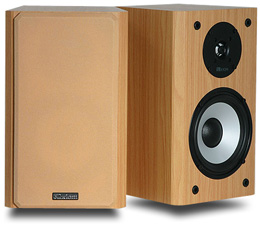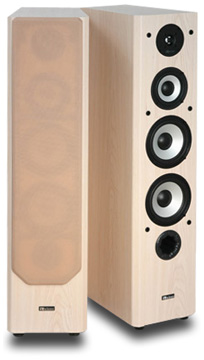More Ways Than One

Axiom Audio's M3 v2 is a two-way speaker with a
1" tweeter and a 6.5" mid-woofer.
|
At least once a week, someone
asks me something like this: Is a two-way speaker better than a three-way, or is it the
other way around? The person asking is usually looking for a
"one-or-the-other" answer, but I have to tell the truth: It depends . . .
Usually, that’s not what they want to hear. But if you
understand how speakers work, you’ll know that there’s more to creating a good
loudspeaker than simply knowing if it’s a two-, three-, or more-way design.
Here’s why.
If you ask speaker designers what characteristics the
"ideal" speaker should possess, you’ll probably hear some or all of the
following: it should cover the bandwidth from 20Hz to 20kHz (i.e., the frequency
range audible to the average human ear), have flat frequency response, exhibit controlled
dispersion, play loudly, have low distortion, and so on. As well, many will tell you that
an ideal speaker should be a point source -- i.e., it should coherently radiate
sound from a single point in space.
The most logically designed speaker, then, would have a
small, single driver in as unobtrusive an enclosure as possible. This would be a
"one-way" loudspeaker. For decades, many companies have tried to produce just
such speakers. In my opinion, though, none has had much success. The reason is that no
one-way speaker I’ve ever heard can cover the audible range and have flat
frequency response and have ideal dispersion and play quite loudly and have
low distortion. There’s just nothing out there that can do it. So, as idealistic as
the notion of a single-driver speaker is, given today’s technology, it just
isn’t feasible for a really good design. Therefore, most designers focus on creating
speakers that use more than one driver.
The next step up from the one-way loudspeaker is, not
surprisingly, the two-way. This usually has one small driver to cover the upper
frequencies (the tweeter), and another to cover the lower frequencies. Some may
call the latter a woofer, but I prefer to call it a mid-woofer, because
it’s used to cover a part of the midrange as well as the bass frequencies. An
electrical network, the crossover, is used to "blend" the two drivers in
the frequency range where they meet. Designing the crossover properly is crucial to get
the two drivers to play together seamlessly, as if they were a single driver.
The two-way loudspeaker overcomes many of the limitations
of the one-way. For example, whereas no single driver can reproduce the entire audible
frequency range well, it’s not that hard to find a good tweeter to handle the upper
midrange and highs, and it’s pretty easy to locate a good mid-woofer to handle the
rest of the midrange and most of the bass. (I say "most" of the bass because, in
almost all two-way designs, super-deep bass is sacrificed in favor of achieving a better
blend in the midrange. Why this tradeoff has to occur is beyond the scope of this article,
but if you read the specifications of two-way loudspeakers, you’ll see that 99% of
them produce little or no bass below 50-60Hz.) Furthermore, because no single driver is
being called on to reproduce all audible frequencies -- two drivers now share that load --
that puts less strain on each, which means that two-way speakers are usually able to
player louder and with less distortion than one-ways. Obviously, the two-way approach
seems closer to the "ideal" loudspeaker.
However, the two-way isn’t perfect. As I said, most
good two-way designs still can’t do low bass well. Furthermore, two-ways introduce a
problem that doesn’t exist in a one-way design, which is, by definition, a
point-source speaker: there are now two drivers, and they’re spaced a little bit
apart. Furthermore, not only do these two drivers produce sound from two different points
in space, there will also be positions at various points around the speaker where they
don’t work as one -- that is, where their outputs don’t blend well. That just
comes with the territory when you try to get two drivers of different characteristics and
placed in different positions to produce sound as if they were occupying the same
point in space. Still, even though the two-way isn’t perfect, the tradeoffs are far
fewer than with a one-way. That’s why two is the minimum acceptable number of drivers
that a credible high-end loudspeaker can have -- and there are a lot of good
two-way designs out there.

Axiom Audio's M60 v2 is a three-way speaker with
a 1" tweeter, a 5.25" midrange driver, and two 6.5" drivers that work
together to deliver deep bass.
|
In the typical three-way design, a
tweeter still handles the highs, but now a third driver is used to reproduce the midrange,
which frees up the woofer to deal with only the bass. Again, a crossover network is used
to blend the drivers at the points where they meet. Three-way designs have some potential
advantages over two-ways. For example, because you now have three drivers, you can use a
bigger woofer to deliver deeper bass, and therefore stretch the speaker’s frequency
response deeper into the low-bass region -- many three-way speakers get a lot closer to
20Hz, the lower limit of human hearing, than can even a properly designed two-way. Some
designers believe that midrange clarity can be improved by having a dedicated midrange
driver, although in practice that’s not always the case. More important, because in a
three-way design the audible frequency range is now divided among three drivers, not two,
it’s possible to design such a speaker to play louder than a comparable two-way
design, and with less distortion. So, the three-way is the better way to go, right?
Not so fast. Three-ways, too, are far from perfect.
There’s still the issue of driver spacing. Whereas, in a two-way, the designer has to
make two drivers blend as one, now he has to get three to work together -- and that’s
not easy. According to many designers, going from a two-way to a three-way introduces not
just a little more complexity -- three-ways are far more complex, and take
far more skill, time, and parts to get them to work properly. And all that extra skill,
time, and parts mean that, all else being equal, a three-way will cost more than a
two-way.
It’s not hard to see that the frequency band can get
split up even further, resulting in four-, five-, and more-way designs. Furthermore, there
are also two-and-a-half- and three-and-a-half-way designs, in which the frequency ranges
handled by two different drivers overlap. However, describing the three-way loudspeaker is
as far as we need to go here to explain why no single approach will guarantee a superior
loudspeaker.
Until some revolutionary changes come along in which the
"ideal" single-driver loudspeaker can be created that has all the
characteristics I’ve described, we’re stuck with two-, three-, and more-way
designs. And while, in theory, one approach may have more potential than another, in
practice each has its strengths and its weaknesses; the quality of the final product
depends on many factors, not just on whether it’s a two- or a three-way design.
For example, this month, Philip Beaudette reviews
Energy’s RC-Mini, a diminutive two-way with quite limited bass response but
exceptional midrange and high-frequency clarity. Because of its bass limitation, as part
of the review, he partners the little RC-Mini with Energy’s S8 subwoofer,
significantly extending the bass and, technically, turning that two-way into a three-way.
The results he achieves are interesting. Philip also reviews Monitor Audio’s Silver
RS6, a floorstanding speaker with unique strengths of its own, some of which have to do
with it being a two-and-a-half-way design, but most of them having to do with aspects of
speaker design that most people don’t ask about. This is another very good
speaker that’s worth checking out.
There’s more than one way to make a good loudspeaker,
which is why, in my opinion, no way can be said to be the best way.
…Doug Schneider
E-mail comments to the editor@goodsound.com.
|